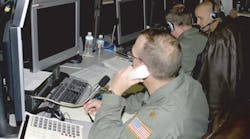By John Rhea
BOHEMIA, N.Y. — The military laboratories, through the use of advanced commercial off-the-shelf (COTS) cards in the MIL-STD 1553 configuration, are beginning to assume more of the design and system integration functions.
This is according to Daniel Arnhols, regional sales manager for Data Device Corp. (DDC) in Bohemia, N.Y. As a result, DDC leaders are extending their line of these cards in the PMC configuration to sit on top of existing VME cards without requiring an additional dedicated chip for extra channels.
DDC already had five 1553 and four ARINC 429 PMC cards available as COTS products. In October company officials launched their BU-65565 1553 four-channel PMC interface card as their leading-edge venture into this emerging market. By year's end Arnhols says he expects to make 11 1553 and 12 ARINC PMC cards available.
DDC has begun shipping evaluation quantities of the BU-65565 to such prime contractors as the Lockheed Martin operation in Orlando, Fla., for use in the U.S. Army's Apache Longbow program. Other DDC shipments of the BU-65565 are going to the Honeywell operations in Clearwater, Fla., for an inertial navigation unit to serve across several platforms.
Arnhols says such military facilities as the Air Force's laboratory at Eglin Air Force Base, Fla., and the Army's Redstone Arsenal in Huntsville, Ala., also want to integrate the new cards, either on VME cards or their own custom backplanes.
The new BU-65565 aims at ground and airborne applications. DDC officials intend their conduction-cooled unit, which costs about $5,500 in single-part quantities, for airborne use. They have a convection-cooled version available for ground-based applications, which costs about $3,500.
The advantage is that the new cards can handle up to four of the DDC's Mini-ACE channels, thus eliminating the need for an additional $500-chip per card, Arnhols says. The DDC parts are to span military requirements from armored personnel carriers to satellite applications, he says.
The company is even following Intel Corp.'s lead by stamping its cards "DDC onboard" as part of its strategy to move with the military's emerging trend toward greater in-house design and integration.
As an example, Arnhols cites the Army's Medium Brigade Initiative, which has emerged within the past four months to look at small mobile vehicles as part of the Army's new stress on units to rapidly deploy from bases in the continental United States.
Design teams are using COTS parts for this purpose at the Army's Tank-automotive and Armaments Command in Warren, Mich., and at the Redstone Arsenal, which manages the multiple launch rocket system program.
Arnhols says he also expects his engineers to add the FibreChannel high-speed databus interface down the road to complement 1553 for the military market and ARINC for commercial users.


